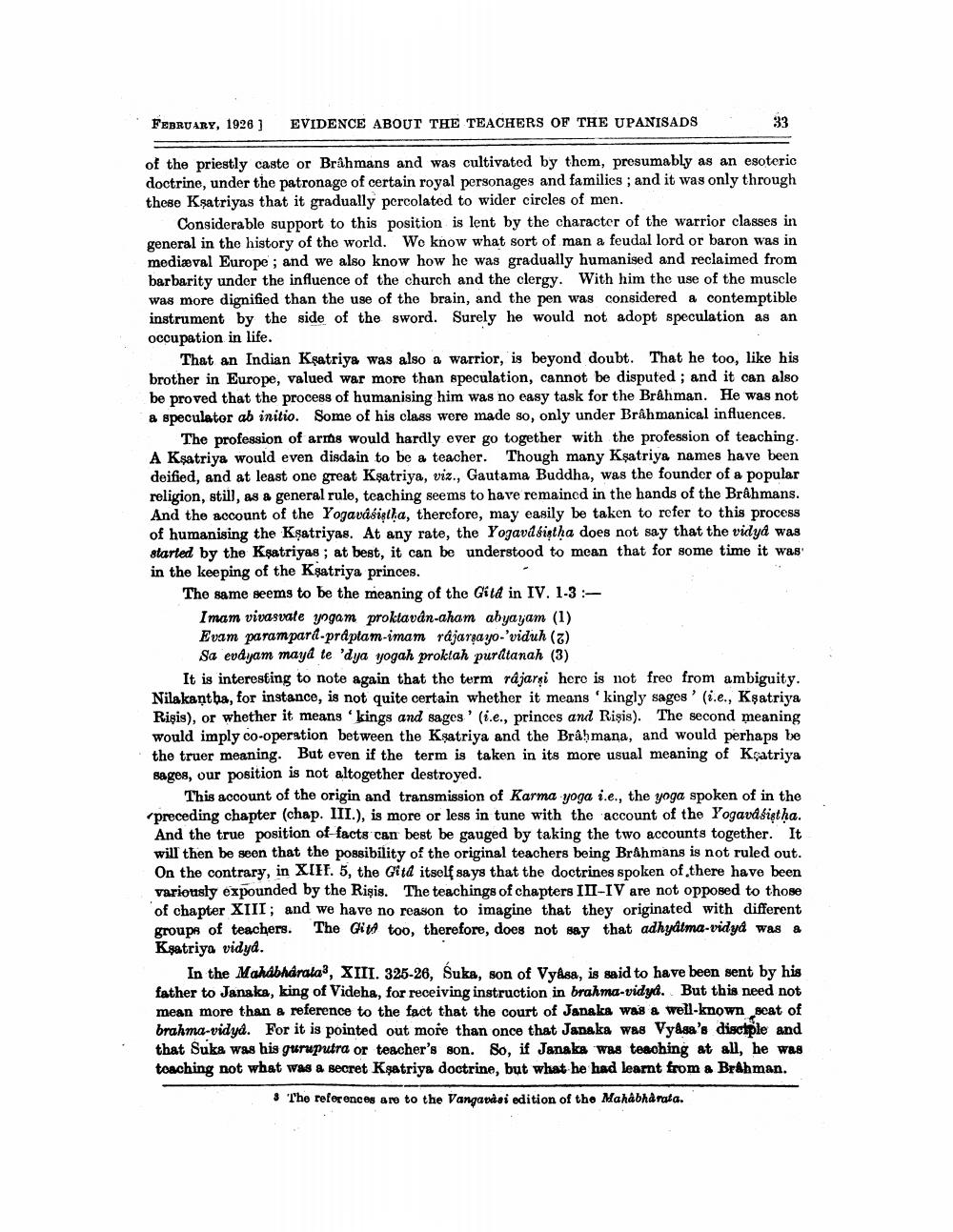________________
FEBRUARY, 1928]
EVIDENCE ABOUT THE TEACHERS OF THE UPANISADS
32
of the priestly caste or Brahmans and was cultivated by them, presumably as an esoteric doctrine, under the patronage of certain royal personages and families, and it was only through these Ksatriyas that it gradually percolated to wider circles of men.
Considerable support to this position is lent by the character of the warrior classes in general in the history of the world. We know what sort of man a feudal lord or baron was in mediæval Europe, and we also know how he was gradually humanised and reclaimed from barbarity under the influence of the church and the clergy. With him the use of the muscle was more dignified than the use of the brain, and the pen was considered a contemptible instrument by the side of the sword. Surely he would not adopt speculation as an occupation in life.
That an Indian Katriya was also a warrior, is beyond doubt. That he too, like his brother in Europe, valued war more than speculation, cannot be disputed ; and it can also be proved that the process of humanising him was no easy task for the Brâhman. He was not a speculator ab initio. Some of his class were made so, only under Brâhmanical influences.
The profession of arms would hardly ever go together with the profession of teaching. A Ksatriya would even disdain to be a teacher. Though many Ksatriya names have been deified, and at least one great Ksatriya, viz., Gautama Buddha, was the founder of a popular religion, still, as a general rule, teaching seems to have remained in the hands of the Brahmans. And the account of the Yogavasistka, therefore, may easily be taken to refer to this process of humanising the Ksatriyas. At any rate, the Yogavd birtha does not say that the vidyd was started by the Ksatriyas ; at best, it can be understood to mean that for some time it was in the keeping of the Ksatriya princes.
The same seems to be the meaning of the Gitd in IV. 1-3 :
Imam vivasvate yogam proktaván-aham abyayam (1) Evam parampard-praptam-imam rájarga yo-'viduh (7)
Sa evdyam mayd te 'dya yogah proktah purltanah (3)
It is interesting to note again that the term rájarsi here is not freo from ambiguity. Nilakantha, for instance, is not quite certain whether it means 'kingly sages' (i.e., Ksatriya Rişis), or whether it means 'kings and sages' (i.e., princes and Rişis). The second meaning would imply co-operation between the Ksatriya and the Brahmana, and would perhaps be the truer meaning. But even if the term is taken in its more usual meaning of Keatriya sages, our position is not altogether destroyed.
This account of the origin and transmission of Karma yoga i.e., the yoga spoken of in the preceding chapter (chap. III.), is more or less in tune with the account of the Yogavdsiştha. And the true position of facts can best be gauged by taking the two accounts together. It will then be seen that the possibility of the original teachers being Brahmans is not ruled out. On the contrary, in XIFF. 5, the Gitd itself says that the doctrines spoken of there have been variously expounded by the Rişis. The teachings of chapters III-IV are not opposed to those of chapter XIII; and we have no reason to imagine that they originated with different groups of teachers. The Gith too, therefore, does not say that adhyatma-vidyd was a Ksatriya vidyd.
In the Mahabharata, XIII. 325-26, Suka, son of Vysais said to have been sent by his father to Janaka, king of Videha, for receiving instruction in brahma-vidya. But this need not mean more than a reference to the fact that the court of Janaka was a well-known _seat of brahma-vidyd. For it is pointed out more than once that Janaka was Vyasa's disciple and that Suka was his guruputra or teacher's son. So, if Janaka Was teaching at all, he was toaching not what was a secret Ksatriya doctrine, but what he had learnt from a Brahman.
The reforonces are to the Vangandai edition of the Mahabharata.




